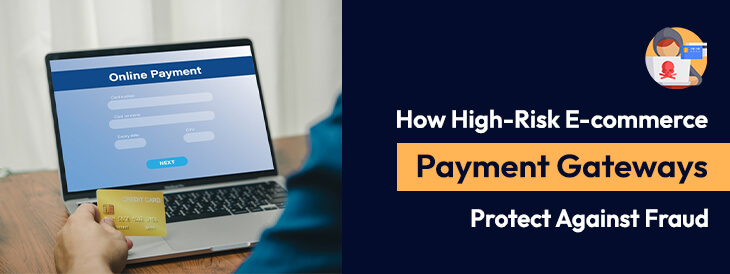How High-Risk E-commerce Payment Gateways Protect Against Fraud
How High-Risk E-commerce Payment Gateways Protect Against Fraud

In today’s digital economy, e-commerce has become a cornerstone of global trade. Businesses of all sizes rely on online platforms to reach customers and process transactions. However, not all e-commerce businesses operate in the same landscape. Some industries, deemed “high-risk” due to regulatory challenges, chargeback rates, or fraud potential face unique hurdles when processing payments.
For these businesses, high-risk e-commerce payment gateways offer a specialized solution to securely handle transactions while protecting against fraud. This article explores what these gateways are, the types of fraud they combat, their key features, and the benefits they provide.
Some Related Blogs
- How to Choose the Best High-Risk Payment Gateway for Your E-commerce Business
- How Secure Payment Gateways Prevent Fraud and Chargebacks in High-Risk Sectors
- Ensuring Security: Key Features of Reliable Payment Gateways for High-Risk Businesses
- The Top Secure Payment Gateway Providers for High-Risk Industries in 2025
Introduction to High-Risk E-commerce Payment Gateways
E-commerce payment gateways are the digital equivalent of a point-of-sale terminal in a physical store. They facilitate the transfer of payment information between a merchant’s website and a bank or payment processor. For most standard online businesses, general payment gateways suffice.
However, high-risk e-commerce businesses—such as those in industries like gambling, adult entertainment, CBD sales, vaping, or subscription services—require more robust systems due to their elevated exposure to fraud and regulatory scrutiny.
High-risk payment gateways are tailored to meet the needs of these industries. They are designed to handle complex transactions, comply with strict regulations, and mitigate the heightened risks that come with operating in a high-risk sector.
Unlike standard gateways, they often include advanced fraud detection tools, flexible underwriting processes, and support for businesses that traditional processors might decline.
These gateways serve as a critical line of defense, ensuring that merchants can operate securely while protecting their revenue and reputation.
Common Types of Fraud in High-Risk E-commerce
Fraud is a persistent threat in e-commerce, but high-risk industries face even greater challenges due to their unique business models. Understanding the types of fraud that target these sectors is essential to appreciating the value of specialized payment gateways. Below are some of the most common fraud threats in high-risk e-commerce:
- Chargeback Fraud: Also known as “friendly fraud,” this occurs when a customer completes a purchase, receives the product or service, and then disputes the charge with their bank to receive a refund. High-risk industries, such as subscription services or online gaming, often see elevated chargeback rates due to buyer remorse or misunderstandings about recurring billing.
- Identity Theft: Fraudsters may use stolen credit card information to make purchases. High-risk merchants, especially those selling high-value or digital goods, are prime targets because these items can be quickly resold or used anonymously.
- Account Takeover: Hackers gain access to customer accounts by stealing login credentials, often through phishing or data breaches. Once inside, they can make unauthorized purchases or drain stored payment methods.
- CNP Fraud: Card-not-present (CNP) fraud happens when a fraudster uses stolen card details for online transactions where the physical card isn’t required. This is a significant issue for e-commerce, particularly in high-risk sectors with higher-than-average transaction volumes.
- Refund Fraud: In this scheme, a buyer claims they never received a product or service, even if it was delivered, to secure a refund while keeping the item.
These fraud types not only result in financial losses but can also damage a merchant’s reputation and lead to penalties from payment processors. High-risk e-commerce payment gateways are built to address these challenges head-on.
Features of High-Risk Payment Gateways
High-risk payment gateways distinguish themselves from standard solutions through a suite of advanced features designed to combat fraud and ensure smooth operations. Here are some of the key tools and capabilities they offer:
- Advanced Fraud Detection: These gateways use machine learning algorithms and artificial intelligence to analyze transaction patterns in real time. They can flag suspicious activities—like unusual purchase amounts, multiple transactions from the same IP address, or rapid account changes—before approving a payment.
- 3D Secure Authentication: Many high-risk gateways integrate 3D Secure protocols (e.g., Verified by Visa or Mastercard SecureCode), which add an extra layer of verification by requiring customers to input a one-time password or biometric confirmation.
- Chargeback Prevention Tools: Features like real-time alerts, detailed transaction reporting, and automated dispute management help merchants identify and resolve potential chargebacks before they escalate.
- Customizable Risk Management: Merchants can set specific rules, such as blocking transactions from certain countries, limiting purchase amounts, or requiring additional verification for high-value orders, tailoring the gateway to their unique risk profile.
- Multi-Currency Support: High-risk businesses often serve international customers. These gateways support transactions in multiple currencies, reducing the likelihood of declined payments and enhancing the customer experience.
- Integration with Compliance Tools: High-risk industries face strict legal requirements. Payment gateways often include built-in compliance checks to ensure adherence to regulations like anti-money laundering (AML) and know-your-customer (KYC) standards.
- Velocity Checks: These monitor the frequency of transactions to detect anomalies, such as a sudden spike in purchases, which could indicate fraudulent activity.
By combining these features, high-risk payment gateways create a fortified environment that minimizes vulnerabilities while allowing businesses to operate efficiently.
Benefits of Using High-Risk Payment Gateways
For high-risk e-commerce merchants, adopting a specialized e-commerce payment gateway offers several advantages beyond basic transaction processing. These benefits enhance security, improve customer trust, and support long-term growth. Here’s how:
- Reduced Fraud Losses: With sophisticated detection tools and authentication measures, these gateways significantly lower the incidence of fraudulent transactions, protecting revenue and reducing financial strain.
- Lower Chargeback Rates: By identifying risky transactions early and providing robust dispute resolution tools, high-risk gateways help merchants maintain acceptable chargeback ratios, avoiding penalties or account termination from payment processors.
- Improved Approval Rates: High-risk businesses often struggle with declined transactions due to conservative underwriting by traditional gateways. Specialized providers understand these industries and offer higher approval rates, ensuring more sales go through.
- Enhanced Customer Trust: Secure payment processes reassure customers that their data is secure, fostering loyalty and encouraging repeat business—an essential factor in industries where trust can be harder to establish.
- Scalability: As high-risk businesses grow, their payment needs evolve. These gateways are design to scale, supporting to increase transaction volumes and international expansion without compromising security.
- Regulatory Compliance: Operating in a high-risk sector often means navigating complex legal landscapes. Payment gateways with built-in compliance features reduce the burden on merchants, helping them avoid costly fines or legal issues.
- Cost Savings: While high-risk gateways may come with higher fees than standard options, the reduction in fraud-related losses and chargebacks often outweighs the initial investment, delivering long-term savings.
By addressing the specific challenges of high-risk e-commerce, these gateways empower merchants to focus on growth rather than constantly battling fraud or operational setbacks.

Email us anytime!
Email customer service 24/7 at info@payment-guru.com

Call us anytime!
Reach customer care 24/7 at +1 (617) 616-8547
